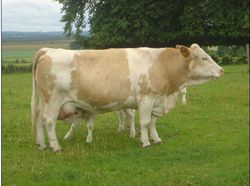Difference between revisions of "Oesophageal Groove"
| (5 intermediate revisions by 3 users not shown) | |||
| Line 1: | Line 1: | ||
| + | {{OpenPagesTop}} | ||
==Introduction== | ==Introduction== | ||
| − | The oesophageal groove is present in newborn ruminants. It is a channel taking milk from the [[Oesophagus - Anatomy & Physiology|oesophagus]] into the [[ | + | The oesophageal groove is present in newborn ruminants. It is a channel taking milk from the [[Oesophagus - Anatomy & Physiology|oesophagus]] into the [[Abomasum - Anatomy & Physiology|abomasum]], bypassing the [[Rumen - Anatomy & Physiology|rumen]], [[Reticulum - Anatomy & Physiology|reticulum]] and [[Omasum - Anatomy & Physiology|omasum]]. |
[[Image:Calf Suckling.jpg|thumb|right|250px|''Calf suckling'' <Br> David Monniaux 2005, WikiMedia Commons]] | [[Image:Calf Suckling.jpg|thumb|right|250px|''Calf suckling'' <Br> David Monniaux 2005, WikiMedia Commons]] | ||
| Line 22: | Line 23: | ||
{{Template:Learning | {{Template:Learning | ||
|flashcards = [[Oesophageal Groove Flashcards]] | |flashcards = [[Oesophageal Groove Flashcards]] | ||
| + | |OVAM = [http://www.onlineveterinaryanatomy.net/content/goat-gastric-groove Image - Goat Oesophageal Groove] | ||
}} | }} | ||
| − | + | {{OpenPages}} | |
[[Category:Stomach - Anatomy & Physiology]] | [[Category:Stomach - Anatomy & Physiology]] | ||
[[Category:A&P Done]] | [[Category:A&P Done]] | ||
| + | [[Category:Alimentary Anatomy - Cattle]] | ||
Revision as of 13:59, 17 October 2014
Introduction
The oesophageal groove is present in newborn ruminants. It is a channel taking milk from the oesophagus into the abomasum, bypassing the rumen, reticulum and omasum.
Formation of the Groove
The groove is formed by posture of the animal lifting its head to suckle. Calcium ions are obtained from the milk. A teat or teat-shaped experience aids the formation. The formation of the groove can be overridden, e.g. bucket feeding calves.
Groove Closure
It is an unconditioned reflex when the animal is eager for milk. Water consumption does not usually initiate groove closure. The age when the rumen becomes fully functional and the oseophageal groove closes differs between ruminants; In calves 20 weeks, in lambs 8 weeks, in deer 16 weeks and in goats 12 weeks. It closes by reflex stimulation of the cranial laryngeal branch of the vagus nerve (CN X) (takes 2-5 seconds). With time it becomes a conditioned reflex. The closure consists of two movements, the lips of the groove become firmly opposed and shorten and the lips become inverted and twisted around the axis of the right lip of the groove, drawing the reticular mucosa over the right lip.
Function in the Adult Ruminant
The groove is stimulated in adult ruminants by ADH. The groove can also be closed in adult ruminants by the administration of drugs, e.g copper sulphate, which is of use to prevent drugs becoming diluted in the forechambers. Instead, it directs the drugs directly to the abomasum.
Histology
The floor of the groove is smooth and pale lined with stratified squamous epithelium.
| Oesophageal Groove Learning Resources | |
|---|---|
 Test your knowledge using flashcard type questions |
Oesophageal Groove Flashcards |
Anatomy Museum Resources |
Image - Goat Oesophageal Groove |
Error in widget FBRecommend: unable to write file /var/www/wikivet.net/extensions/Widgets/compiled_templates/wrt661ed0dea14df9_88475887 Error in widget google+: unable to write file /var/www/wikivet.net/extensions/Widgets/compiled_templates/wrt661ed0deaa3238_45555946 Error in widget TwitterTweet: unable to write file /var/www/wikivet.net/extensions/Widgets/compiled_templates/wrt661ed0deb14ff6_85663663
|
| WikiVet® Introduction - Help WikiVet - Report a Problem |
